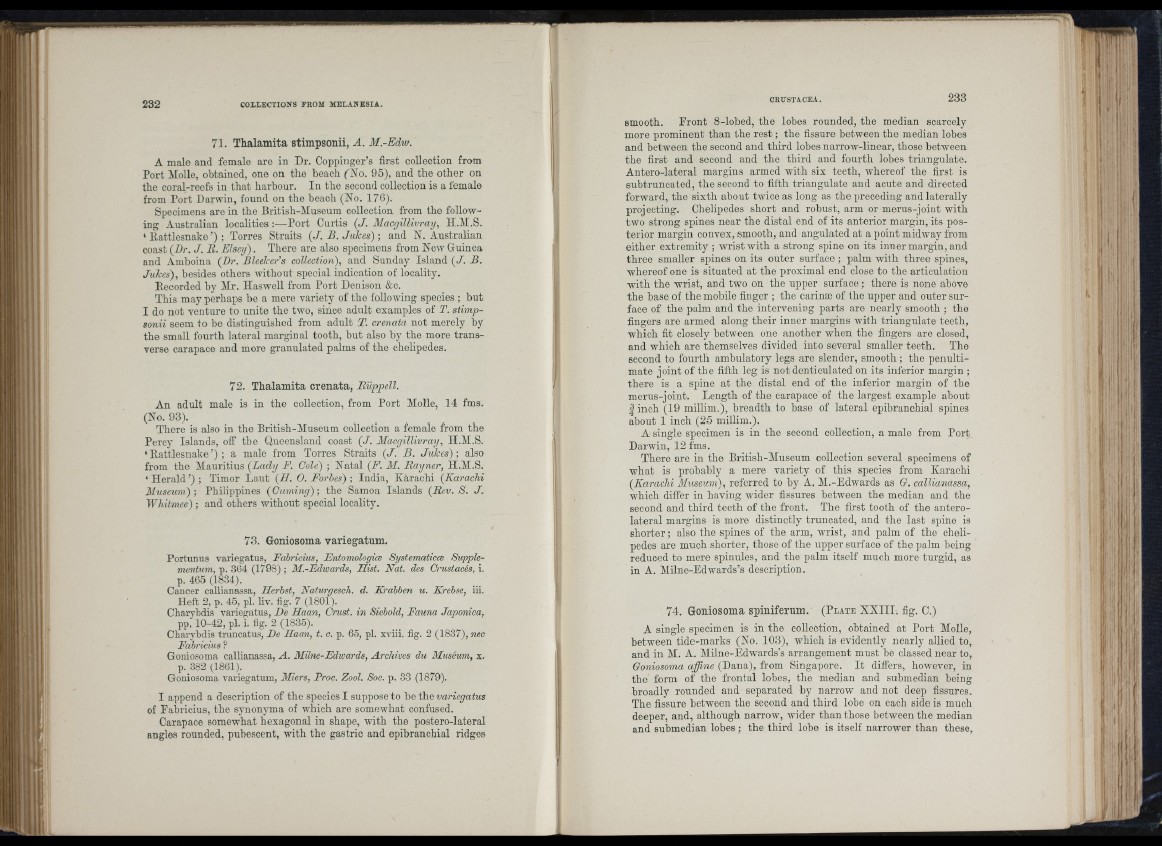
IJ'»"«
w
iii'
‘■f
I r i
ill!
i"*1 ir
li I t
11
H- * iI * yI
’! Í
oi i
71. Thalamita stimpsonii, A . M.-Edw.
A male and female are in Dr. Coppinger’s first collection from
Port Molle, obtained, one on the beach (No. 95), and the other on
the coral-reefs in that harbour. In the second collection is a female
from Port Darwin, found on the beach (No. 176).
Specimens are in the British-Aluseum collection from tho following
Australian localities :—Port Curtis {J. Alacgillivray, H.AI.S.
‘ Battlesnake ’) ; Torres Straits {J. B. Juices); and N. Australian
coast {Dr. J. B . Elsey). There are also specimens from Now Guinea
and Amboina (Dr. Bleelcer’s collection), and Sunday Island (J. B .
Jiihes), besides others without special indication of locality.
Becorded by Mr. Haswell from Port Denison &c.
This may perhaps be a mere variety of the following species ; hut
I do not venture to unite the two, since adult examples of T. stimpsonii
seem to be distinguished from adult T. crenata not merely by
the small fourth lateral marginal tooth, but also by the more transverse
carapace and more granulated palms of the chelipedes.
72. Thalamita crenata, Büppell.
An adult male is in the collection, from Port Molle, 14 fms.
(No. 93).
There is also in the British-AInseum collection a female from the
Percy Islands, off the Queensland coast {J. Alacgillivray, H.M.S.
‘ Battlesnake ’) ; a male from Torres Straits {J. B. Juices) ; also
from the Mauritius (Lady P. Cole) ; Natal [P. AI. Bayner, H.Al.S.
‘ Herald ’) ; Timor Laut {H. 0. Forbes) ; India, Karachi {Karachi
Aluseum); Philippines (Cuming); the Samoa Islands (Bev. S. J.
Whitmee) ; and others without special locality.
73. Goniosoma variegatum.
Portimus variegatus, Fabricius, Entomoloyice Systematicæ Supple-
mentum, p. 364 (1798) ; M.-Edioards, Hist. Kat. des Crustacés, i.
p. 465 (1834).
Cancer callianassa, Herbst, Naturgescli. d. Krabben u. Krebse, iii.
Heft 2, p. 45, pi. liv. fig. 7 (1801).
Charybdis variegatus, De Haan, Crust, in Siebold, Fauna Japónica,
pp." 10-42, pi. i. fig. 2 (1835).
Charybdis truncatus, De Haan, t. c. p. 65, pi. xviii. fig. 2 (1837), nec
Fabricius ?
Goniosoma callianassa, A. Milne-Edioards, Archives du Muséum, x.
p. 382 (1861).
Goniosoma variegatum, Miers, Proc. Zool. Soc. p. 33 (1879).
I append a description of the species I suppose to he the variegatus
of Pahricius, the synonyma of which are somewhat confused.
Carapace somewhat hexagonal in shape, with the postero-lateral
■ angles rounded, pubescent, with the gastric and epibranchial ridges
233
smooth. Front 8-lohed, the lobes rounded, the median scarcely
more prominent than the rest ; the fissure between the median lobes
and between the second and third lobes narrow-linear, those between
the first and second and the third and fourth lobes triangulate.
Antero-lateral margins armed with six teeth, whereof the first is
subtruncated, the second to fifth triangulate and acute and directed
forward, the sixth about twice as long as the preceding and laterally
projecting. Chelipedes short and robust, arm or merus-joint with
two strong spines near the distal end of its anterior margin, its posterior
margin convex, smooth, and angnlated at a point midway from
either extremity ; wrist with a strong spine on its inner margin, and
three smaller spines on its outer surface ; palm with three spines,
whereof one is situated at the proximal end close to the articulation
with the wrist, and two on the upper surface ; there is none above
the base of the mobile finger ; the carinæ of the upper and outer surface
of the palm and the intervening parts are nearly smooth ; the
fingers are armed along their inner margins with triangulate teeth,
which fit closely between one another when the fingers are closed,
and which are themselves divided into several smaller teeth. The
second to fourth ambulatory legs are slender, smooth ; the penultimate
joint of the fifth leg is not denticulated on its inferior margin ;
there is a spine at the distal end of the inferior margin of the
merus-joint. Length of the carapace of the largest example about
I inch (19 millim.), breadth to base of lateral epibranchial spines
about I inch (25 millim.).
A single specimen is in the second collection, a male from Port
Darwin, 12 fms.
There are in the British-Museum collection several specimens of
what is probably a mere variety of this species from Karachi
(Karachi Aluseum), referred to by A. Al.-Edwards as G. callianassa,
which differ in having wider fissures between the median and the
second and third teeth of the front. The first tooth of the anterolateral
margins is more distinctly truncated, and the last spine is
shorter ; also the spines of the arm, wrist, and palm of the chelipedes
are much shorter, those of the upper surface of the palm being
reduced to mere spinules, and the palm itself much more turgid, as
in A. Alilne-Edwards’s description.
I
: I
74. Goniosoma spiniferum. (P late X X III. fig. C.)
A single specimen is in the collection, obtained at Port Alolle,
between tide-marks (No. 103), which is evidently nearly allied to,
and in AI. A. Alilne-Edwards's arrangement must be classed near to,
Goniosoma affine (Dana), from Singapore. I t differs, however, in
the form of the frontal lobes, the median and submedian being
broadly rounded and separated by narrow and not deep fissures.
The fissure between the second and third lobe on each side is much
deeper, and, although narrow, wider than those between the median
and submedian lobes; the third lobe is itself narrower than these,
L i
Í . '
, 1!
ii
!! I
I Í
II
[
!ii (
r i